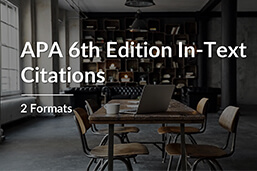
In-text citations are a cornerstone of academic writing, and in APA style (American Psychological Association) in the 6th edition format, they serve as a key method for assigning credit to the original sources of information. APA 6th edition in-text citations guide readers to the full reference in your reference list at the end of your paper, and help to avoid plagiarism. This article closely outlines the format and proper use of APA 6th edition in-text citation.
Definition of APA 6th edition in-text citation
In-text citations are used in APA style to quickly document the source of your information and refer to the full source reference at the end of the paper. The format of the APA 6th edition in-text citation typically includes the author’s last name and the year of publication, and page numbers if a direct quote is used.
Parenthetical vs. Narrative citation
There are two types of APA 6th edition in-text citations, parenthetical citation and narrative citation. Learn how to differentiate between those two in the below.
Parenthetical in-text citations
In bracket in-text citation, the author’s name and the date of publication (or other similar types of information) are included in brackets.
Narrative in-text citations
The author’s name appears within a statement, and the date comes directly after it in brackets.
Short vs. Long (block) quotations
Short and long quotations are used in APA 6th edition in-text citation in different ways. The main differences between the two types are outlined in the table below:
| Short quotations | Long quotations |
| Put the quote between double quotation marks and include it in the text. | A block quotation should not be enclosed by quotation marks. |
| Incorporates the author's name, year of publication, and the page number. | It should begin on a new line and be indented by 0.5 inches from the left margin. |
| Include the author, date, and page number if the author and date are not mentioned in the text. | The bracket should be followed by a full stop. |
| E.g. (Burnside, 2016, p. 210). | Do not include additional space before or after the block quotation; simply double-space it. |
The APA 6th edition in-text citation depends on the number of authors. The table below illustrates the appropriate style to use for each case:
In some cases, APA 6th edition in-text citations may have some missing elements, such as unknown authors, dates, or page numbers. These should be cited as follows:
No author in APA in-text citation
If no author or creator is provided, APA 6th edition in-text citation stipulates that you should use the name of the organisation that published the work.
If you are unable to find the organisation responsible for the work, you can format your APA 6th edition in-text citation using the title of the source.
Missing publication date in APA 6th edition in-text citation
In APA 6th edition in-text citation, we use the acronym n.d., which stands for “no date” if there is no date associated with a source and is enclosed in brackets.
Missing page number in APA 6th edition in-text citation
When directly citing in the text of your work, you should generally provide page numbers if they are provided. If no page numbers are provided, put the term “para.” before the paragraph number instead of the page number.
If there is only one paragraph and you must provide an APA 6th edition in-text citation, give the author’s last name and the year, but omit the page number.
APA 6th edition in-text citation – Multiple sources
Use brackets in APA 6th edition in-text citation to illustrate an idea supported by several sources. The sources should be separated by a semicolon and presented in alphabetical order.
Arrange two or more works by the same author in chronological order, beginning with the year of publication. Begin with citations without known dates then arrange the rest in chronological order and conclude with in-press citations.
Mention the writers’ surnames just once; for each subsequent work, only the date is given.
Ambiguous APA 6th edition in-text citations
APA 6th edition in-text citations may be ambiguous if they are consistent with several references. For such cases, use the format below:
FAQs
Use the source’s title in the signal phrase or the first word or two in brackets. Keep titles of articles, chapters, and web pages in quotation marks and the names of books and reports in italics. When essential words in titles are written in the text, they must be capitalized according to APA style.
You must include an in-text citation every time you summarize, paraphrase, or generally use ideas that are not your own. This might include ideas or recommendations for best practices.
The in-text citation can be included in brackets at the end of other sentences or paragraphs as a substitute. Identify the source of each subsequent statement by utilizing qualifiers like “That article concludes,” “According to,” or “They also state.”
Provide the author’s name in the first entry alone and include three hyphens in place of the name, followed by a full stop and the title. The name is represented by the three hyphens exactly as it appears in the previous entry.
